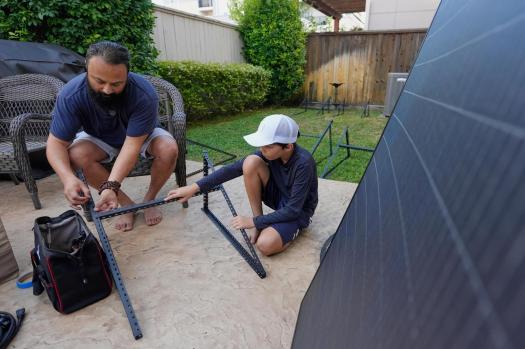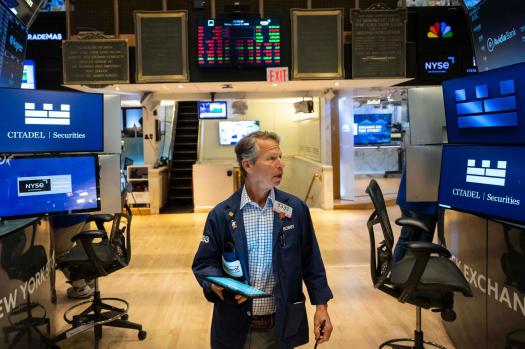Written by Isabel O. Malley
Terrence Dwyer was immediately convinced after he got a knock on his door and a flier for a solar panel system that was tiny enough to put on his deck. Due to their low cost and ease of installation, solar systems that connect to standard wall outlets have been well-liked in Europe for many years and are becoming more and more popular in the United States.
Related Articles
-
Puerto Rico cashes in on Bad Bunny as thousands flock to the island for his concerts
-
US stocks tap the brakes as Wall Street heads toward the finish of a record-setting week
-
What does it mean to be rich? We asked 3 people
-
Retail sales rise 0.5% in July as some shoppers step up purchases ahead of tariffs
-
National Roller Coaster Day: Orlando list, first to freshest
“We definitely thought, let’s do this immediately,” Dwyer, a resident of Oakland, California, said.
With President Donald Trump’s comprehensive budget and policy package eliminating residential rooftop solar tax credits, more homeowners may find these small-scale solar systems appealing and turn their attention to less expensive options. Manufacturers of the smaller systems, known as plug-in or balcony solar, were already seeing signals of rising demand before the GOP plan passed. One such indication was a new Utah law that streamlined requirements for homeowners to purchase and install these systems. Due to a lack of understanding, inconsistent utility regulations, and restricted availability, door-sized systems have not been as generally adopted in the United States as they have been in Europe.
Two 400 watt panels, an inverter, a smart meter, and a circuit breaker make up the $2,000 plug-in solar system that was put up on Dwyer’s backyard deck in March. He claims that lowering his carbon footprint was his main motive, even if it also saves him about $35 a month on his power bill because he is using less energy from the grid.
“We wanted to get involved with solar in some way because we like the environmental benefits of solar,” Dwyer added.
Dwyer would have spent $30,000 to renovate his roof to accommodate the panels and $20,000 for the installation if he had chosen rooftop solar.
Plug-in solar system installation involves some homework. Potential buyers should first review their utility’s policies because power providers have different policies about what they allow their customers to do with energy-generating equipment. Depending on the municipality, building permissions may be necessary. While some systems may be setup by oneself, others would need an electrician. Certain kits, for instance, contain meters that need to be connected to a home’s circuit breaker.
Dwyer purchased his system from Bright Saver, a California group that promotes plug-in solar. The company sells a smaller model for $399 that sold out in six days, in addition to the one Dwyer purchased.
According to Cora Stryker, one of the founders of Bright Saver, the demand and interest have been tremendous. It is evident that we are striking a chord since many Americans have long desired solar energy but have not yet been presented with a viable and reasonably priced choice.
According to Kevin Chou, another Bright Saver founder, utility practices that leave users unsure of their legality and a dearth of state and local regulations that specify which regulations apply have prevented the systems from being widely used in the United States.
Plug-in solar systems need the same interconnection applications as rooftop panels that feed electricity back into the larger network, according to certain utilities The Associated Press spoke with. However, since plug-in solar systems, in contrast to rooftop systems, are made to stop electricity from flowing to the grid, Steven Hegedus, a professor of electrical engineering at the University of Delaware, said he doesn’t understand why a utility would need to require an interconnection agreement.
Customers should still abide by their utility’s guidelines if they are unsure.
Since consumers are purchasing less energy, utilities are likely to oppose plug-in solar in its early stages of expansion, according to Robert Cudd, a research analyst at the University of California, Los Angeles’ California Center for Sustainable Communities.
According to Cudd, utilities truly want all of their customers to be dependable and giving with the electricity they provide.
By creating safety conditions like being certified by a nationally renowned testing body like Underwriters Laboratories and exempting specific small-scale installations from interconnection agreements, Utah passed an innovative law this year that supports plug-in solar. The National Conference of State Legislatures claims that it is the only state that has enacted legislation in favor of plug-in solar.
The legislation’s backer, Republican state representative Raymond Ward, said that the smaller systems let consumers better control their energy costs and sources.
These are found across Europe. They are available for purchase, effective, and in high demand. Ward stated that there is no reason why they shouldn’t be present in the United States.
According to Bright Saver, they are advocating for comparable legislation in other states.
The dean of the University of Columbia Climate School, Alexis Abramson, praised Utah’s action as well.
According to her, we truly need more states and cities to make provisions for this kind of technology.
The amount that clients could save is still up for debate. According to Severin Borenstein, a professor at the Haas School of Business at the University of California, Berkeley, the price of certain portable solar systems in the US would make it difficult for users to save money on their power bills during the course of their ownership. According to his calculations, a $2,000 system in the US would cost roughly $0.20 per kilowatt-hour over a 25-year period, which would only be cost-effective for those with high electricity bills. The average cost of systems marketed in Europe, according to Borenstein, is roughly $600. This amounts to about $0.05 or $0.06 per kilowatt-hour over a 25-year period.
Craig Keenan, a resident of Baltimore, said that he put one of the smaller Bright Saver devices on his balcony in July for reasons other than just financial savings.
He stated that the quantity of carbon emissions that we as a species produce is extremely unsustainable for our planet, which is why I’m interested in renewable energy.
He stated that it would take him roughly ten years to recover the cost of the kit because he anticipates saving about forty dollars a year on power costs thanks to the system.
According to mechanical engineer Keenan, the installation process took him ten to fifteen minutes.
He said, “I believe anyone can install this.” It’s not difficult. A technical degree is not necessary.
Craftstrom, situated in Texas, is one of the several businesses that sells plug-in solar kits. Since 2021, it has sold over 2,000 systems in the US, primarily in Florida, Texas, and California. A solar panel that can be installed in a backyard or other sunny area is included in the company’s basic kits, along with tools like an inverter and smart meter to control and maintain the energy flow.
Craftstrom’s chief revenue officer, Kenneth Hutchings, stated that the company’s U.S. sales increased this year even before the GOB tax law was passed, and he anticipates that once federal rooftop solar subsidies expire, demand for plug-in solar would rise even more.
Michael Scherer, one of Craftstrom’s founders, stated that although the company urges clients to notify their power company prior to installation, no utility has ever objected.
If enabling legislation is implemented, China-based EcoFlow intends to start selling plug-in solar systems in Utah and then go on to other states, according to company spokesperson Ryan Oliver.
Oliver stated that this is an instance of technology being somewhat ahead of the authorities. He also added that as the product becomes more widely available, we anticipate that it will gain traction as people gain a better understanding of it.
___
Mingson Lau, a video journalist for the Associated Press in Baltimore, helped with this story.
Several private foundations provide funding for the Associated Press’s coverage of the environment and climate. All content is the exclusive responsibility of AP. Visit AP.org to find funded coverage areas, a list of supporters, and AP rules for dealing with philanthropies.





















